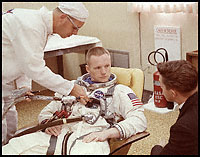Other Work
Armstrong's Code
[Magazine profile of Neil Armstrong, first man on the moon, on the 30th Anniversary of that flight.]
By Kathy Sawyer
Washington Post Magazine | Cover Story, Sunday, July 11, 1999; Page 10
For complete article, see: http://www.washingtonpost.com/wp-srv/national/longterm/space/armstrong1.htm
 It was an autumn day in 1979, and Neil Armstrong had been back on planet Earth for almost 10 years. A middle-aged man with a bit of a paunch, thinning hair and a need for spectacles, he was at work on his farm near Lebanon, Ohio, a terrestrial dream of rolling pasture with a brook running through it and cows grazing under big skies. As he jumped off the back of his grain truck, he caught his wedding ring on a latch, shredded his finger and tore off the tip.
It was an autumn day in 1979, and Neil Armstrong had been back on planet Earth for almost 10 years. A middle-aged man with a bit of a paunch, thinning hair and a need for spectacles, he was at work on his farm near Lebanon, Ohio, a terrestrial dream of rolling pasture with a brook running through it and cows grazing under big skies. As he jumped off the back of his grain truck, he caught his wedding ring on a latch, shredded his finger and tore off the tip.
''Instead of screaming and running for a doctor, he scooted around until he found his finger,'' a friend recalls. He put it on ice, then ''got in his car and drove'' to a nearby hospital.
Eventually, microsurgery specialists at Jewish Hospital in Louisville, Ky., managed to stitch two arteries and five veins, restore blood circulation and feeling. But the finger was a bit redder than the rest of his hand, and, for a time, he massaged it as the doctor advised, a practice some mistook for a nervous tic. He tried to convince reporters the injury was not news.
Solitary, self-sufficient, cool under fire and so taciturn that he is apt to be misunderstood, Armstrong climbed more carefully out of another sort of vehicle and into the history books 30 years ago this month. An audience estimated at 500 million watched on television and millions more tuned in by radio as Armstrong became the first human to step onto an alien world.
At few other moments has one person become the fulcrum of such weighty imperatives — to win a famous victory for America and vindicate a vast investment of national treasure, to penetrate a hostile frontier, to master a new technology, to navigate a harrowing descent to the unknown — all in the glare of rapt global attention. By the time he landed in the Sea of Tranquility, the country boy from Ohio had already spent most of his adult life in jobs where intensity of focus and the threat of violent death were part of his daily routine. He was used to all of that. It was, instead, the loss of privacy that appalled him. He loved to fly, and he loved his country, and in the name of those passions he was willing to risk not only his hide but a piece of his soul.
Only a piece, however — a mere finger's worth — and no more.
Twelve Americans walked the barren moonscape from 1969 to 1972. But Armstrong, 68, remains unique in his firstness — and in his aloofness ever since. He holds a record that can never be broken but that might, in other hands, have been tarnished. He can seem arrogant, cold and as distant as the lunar far side. . .


